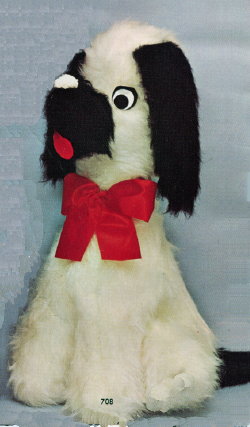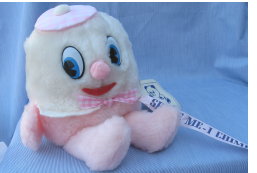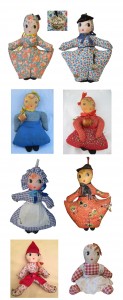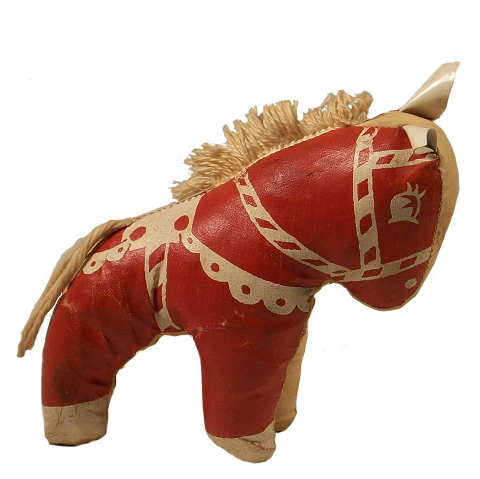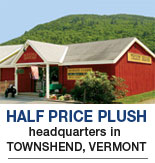I found a 70 Year Old Stuffed Camel Pincushion my Mother Made
80 Years ago my Mother and Dad started a small business in New York City that made small stuffed animal pincushions. From those pincushions which are today as up-to-date as the buggy whip, evolved a company that manufactured stuffed plush toys. Mary Meyer was my Mother and she and Dad started Mary Meyer Manufacturing Co. in NYC in 1933.
The first few years they made Animal Pincushions, which were scotties, lambs, horses, and elephants. Mother was the designer and the maker and Dad, Hans Meyer, was the salesman. He travelled all over the eastern half of the USA and sold animal pincushions to department stores and 5¢ & 10¢ chain stores like Woolworths.
Dad was a great salesman and kept a good size crew of ladies busy sewing, stuffing and making stuffed animal pincushions.
After World War 2 women didn’t sew their own clothing as much as they use to and there wasn’t a need for a stuffed animal pincushion to store their pins and needles in. Mothers did not make all of the family’s clothing the way they did in the 1930s and 40s.
When I was 12 years old I helped Dad carry cartons containing order shipments to the post office for shipping to 40 to 50 Woolworth stores or department stores. In each carton was one, two or three dozen 5” to 7” stuffed animal pincushions for each “5¢ & 10¢” branch store.
Whether I knew it or not, I was being exposed to a business, that I later joined after college and a tour with the US Army in the mid 1950s.
Mother grew up in New York City and learned the dressmaking trade at Manhattan Trade School for Girls. She loved to sew and helped the business grow. They first made Tomato Pincushion, then animal pincushions and finally stuffed plush toy animals. Today that business is in southern Vermont. Over those 80 years Mary Meyer has made many millions of stuffed toy animals and probably a few hundred thousand animal pincushions.
Today I answer emails from adults who have grown up with our toys and want to know something about their teddy bear or stuffed dog that they had for 20, 30 or 40 years ago. I’m pretty good and I can tell them what is ours and what is not and it’s history. It’s like looking at one of your kids and saying “I know that kid. He’s one of mine”.
This past week I saw a Camel animal pincushion that I haven’t see for 70 years, but I knew it was one of ours. Stuffed Camels were never in great demand. Dogs, Cat and Teddy Bears are the most popular designs, followed by Lambs and Rabbits. Camels are fairly far down the list of popularity.
 How many Camels did Mother make? Well, I have to guess at some of these
How many Camels did Mother make? Well, I have to guess at some of these
answers, because there are no records saying “x number of pieces”. I’m
guessing they were made from 1939 through 1945. If there were one Camel
per dozen assorted pincushions, there could be 5,000 or more Camel
pincushions made during that period.
A Mary Meyer collector friend of mine sent me a photo of her Camel. Keep in mind this pincushion is 70 years old and she bought it after it had been used for many years. It’s faded and the ribbon is frizzy. Pincushions were all made of cotton percale fabric, stuffed with cotton batting, with sewn on felt eyes, nose and tongues, with a satin neck-ribbon, with a tiny spool of thread and 5 brass safety pins attached. They did not have a sewn in tag stating the name of the maker as we do today.
The Mary Meyer Camel pincushion is 7″ long and 6½” high. If you look at the belly of the Camel the fabric is not as faded as the fabric on the sides. It is still stuffed fairly firmly, but the safety pins are gone. This pincushion is still in pretty good shape considering it over 70 years old.
Why am I writing this? Well, I wonder, are there any more Camels or other stuffed animal pincushions out there? I have a few and I’m looking for others. There are dogs, cats, horses, lambs, dolls, elephants, dolls and camels. We also made toys out of oilcloth, but I’ll save that story for another day.
I’m a stuffed toy detective. I spent 30 years designing and making stuffed toy animals and now I’m looking for some of the products my family made 60 to 70+ years ago. I am hoping there are some animal pincushions hidden in attics and garages all over this huge country, that will jump out and say “Here I am”. Hopefully their owners will email me.
If you find something you would like me to see, you can contact me at wallym@svcable.net. I would love to hear from you.
by Walter Meyer
Mary Meyer Corp.
Townshend, VT – USA
Photos by Linda Laughlin


